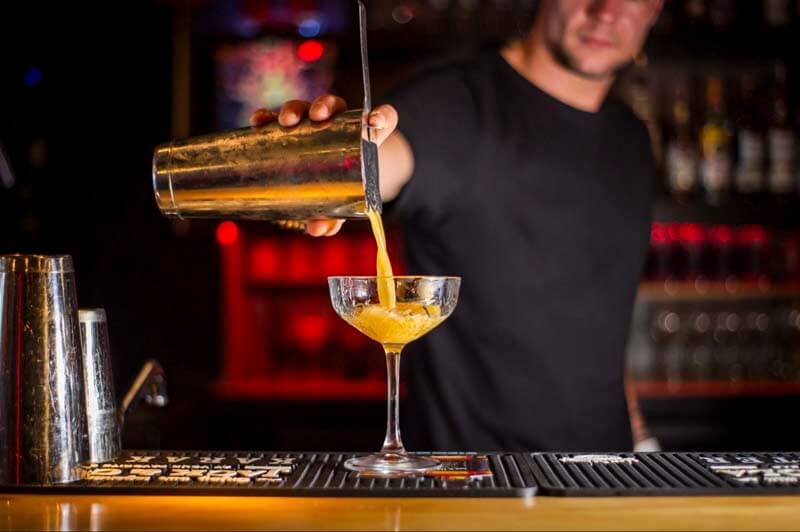
Here is a staggering fact: Over 726,936 bartenders currently work in the United States, according to demographic information from Zippia.
And that number is only going to get higher. According to the U.S. Bureau of Labor and Statistics, the employment of bartenders is projected to grow eighteen percent from 2021 to 2031, with about 105,300 openings for bartenders projected each year, on average, over the next decade.
Many of those positions are anticipated based on the need to replace workers who change careers or retire.
If your business is looking to hire a bartender who has the proper bartending licenses and skills, keep reading as we break down salaries and tipping expectations for bartenders.
What We’ll Cover in This Piece:
What’s the Salary Range for Bartenders?
The average annual salary range for a bartender is about $26,350 or $12.67 per hour before tips.
Other hiring sites like Glassdoor and Salary also report a bartender’s annual salary within a range between $23,000 – $27,000, not including tips.
Location, industry size, and prior bartending experience all affect a bartender’s salary.
For example: Here is a breakdown of the top three states that pay bartenders the most; they fluctuate from $60,000 in Hawaii at the top to $41,000 in Arizona.

Photo by Bjarne Vijfvinkel on Unsplash
Top Three Highest-Paying States for Bartenders *
- Hawaii – $60,000+
- Washington, D.C. – $54,000+
- Arizona – $41,000+
* Facts polled about US bartender statistics from Serving Alcohol
Although Hawaii, Washington, D.C., and Arizona pay their bartenders the most, the following three states are actually most in-demand for bartenders.
Top Three States That Hire the Most Bartenders *
- California
- Florida
- Texas
* Facts polled about US bartender statistics from Serving Alcohol
You’ll notice that these average salary estimates are broken down “before tips” or “not including tips.” That’s because, even more than salaries, most bartenders rely heavily on the gratitude of thirsty customers.
Especially in the United States, tipping is a huge part of the drinking culture.
Let’s talk about tips for bartenders.
What’s the Average Tip Per Drink?
It takes practice to pour the perfect cocktail or to understand the right glass to serve a Manhattan or the proper pint glass to pour a stout! Such skills can determine a high-earning evening for a bartender.
According to Serving Alcohol’s US Bartender Statistics, on a slow night at a small-town pub, bartenders can make as little as $40 in tips, while on a busy night in a more cosmopolitan club, they can make as much as $1,000 in one shift.

Photo by scottishstoater on Unsplash
General guidelines show that Americans tip on average $1 per beer, a glass of wine, or a straightforward mixed cocktail. Sometimes if the bartender takes extra time to make a nice cocktail, a patron might tip $3 to $4 for each drink.
So if you do that math, a bartender making an average of $13 per hour and approximately $150 per day in tips can collect an annual salary between $55,000 and $60,000 annually.
Now, this number can differ based on whether you decide to let your bartenders keep their own tips or if you pool tips to split amongst your entire back of house. Either way, read up on our guide to reporting tips to the IRS to make sure you’re in compliance.
Here’s a Tip: If it supports the tone of your business, a tip jar can be a great addition to generating more tips for your bartenders. Here are 30 Tip Jar Ideas to get your customers in a giving mood.
Last Call! Two Important Notes Before Hiring a Bartender
Make Sure They Have a Barback
Beyond mixing and serving cocktails, slicing lemon wedges, and processing payments, bartending also requires providing excellent customer service. Help your bartenders by providing them with an incredible team of barbacks.
By replenishing garnishes, napkins, and fresh glasses, barbacks help keep your establishment running smoothly every day and your bartenders busy slinging drinks.
If you’re becoming a new bar owner or looking to improve your current bar staff, read our advice on how to hire a knowledgeable, hard-working barback. Be Sure Your Bartenders Have the Necessary Licenses*
Is a license required for bartenders to serve or sell alcohol in your state, city, town, or county?
We’ll admit: The answer isn’t simple.

Photo by Helena Lopes on Unsplash
While there is no official, national certification to serve or bartend alcohol in the United States, some states do mandate that your bartenders pass training sessions on issues like alcohol overconsumption or the fundamental laws governing alcohol in your area.
For example, bartenders in California are required to complete and pass the California RBS Training Certification exam.
Check out our Untappd for Business reference manual to find out the specific regulations in your state.
* For the most up-to-date laws in your area, please check with your local Alcohol Beverage Authority.
Other Content You May Enjoy
To succeed and grow your restaurant, bar, or brewery you need to stand out in local search results. Whether someone is searching for the “best craft beer near me” or “top-rated seafood restaurant in [your city],” Local SEO (Search Engine Optimization) helps your business appear at the top of those search results.
With 81% of consumers using Google Search and Maps to find local businesses, and nearly 90% of customers choosing a business on the first page of search results, optimizing your online presence is essential.
This guide will walk you through Local SEO strategies tailored for restaurants, bars, and breweries, covering Google My Business, website optimization, online reviews, local backlinks, and more.
By the end of this guide, you’ll have a step-by-step action plan to increase your search rankings, attract more local customers, and grow your business.
In today’s digital world, having a well-designed, functional website is essential for restaurants, bars, and breweries. It goes beyond having social media. A great website can help attract new customers, showcase menus, accept reservations, and even drive online sales. But one of the most common questions business owners ask is: How much should a website cost in 2025?
The answer depends on several factors, including the type of website, features, complexity, and whether you choose a DIY solution or hire a professional web developer. Costs can range from a few hundred dollars for a basic website to tens of thousands for a fully customized, feature-rich platform.
This guide will break down website costs for restaurants, bars, and breweries, helping you understand the pricing landscape and choose the best solution for your business
Trivia nights have become an incredible marketing strategy for bars, restaurants, and breweries to draw in crowds and engage with new customers. With the recent collaboration between Geeks Who Drink, Timeplay, and the iconic television show Jeopardy!, businesses now have an exciting opportunity to host the Jeopardy! Bar League. This partnership combines the global brand recognition of Jeopardy! with Timeplay’s cutting-edge technology and the fun of live trivia from the experts at Geeks Who Drink.
In this piece we’ll cover what this new collaboration between these two trivia powerhouses is and how you can bring this unique experience to your venue.
In today’s world, both websites and social media platforms are crucial for a brewery, bar, or restaurant’s online presence. However, consumer habits show distinct preferences for each, depending on the context of their search or interaction.
In this guide, we’ll go over the basics, walk you through how to leverage these tools effectively, and show you how understanding these trends can help your venue better meet your customers’ expectations.
As a restaurant, bar, brewery, or any venue with a food and beverage program, having a modern, functional, and aesthetically pleasing website isn’t just a luxury—it’s a necessity.
No matter the size of your business, your new potential customers often interact with your website first—and first impressions matter.
In this piece, we’ll explore the top website trends shaping the online presence of hospitality businesses in 2025. These trends will help your venue stand out and attract more customers while creating a unique and modern experience to establish the perfect guest experience from start to finish.
For bar owners, hospitality managers, and small business owners, selecting the right gin brands is more than just filling the shelves—it’s about curating a distinctive customer experience. Gin has soared in popularity, becoming a staple of modern cocktail culture. With its complex botanical infusions, gin offers versatile, memorable flavors that can attract a wide range of customers. But with so many choices available, which brands should you prioritize to bring out the best in your gin menu?
This guide explores the seven best gin brands that have proven themselves through quality, craftsmanship, and unique flavor profiles. By understanding what makes each brand special, you and your staff will be better equipped to create a standout gin selection that delights your patrons, reinforces your brand’s reputation with a robust gin drinks menu, and helps you continue crafting classic and innovative gin cocktails.

